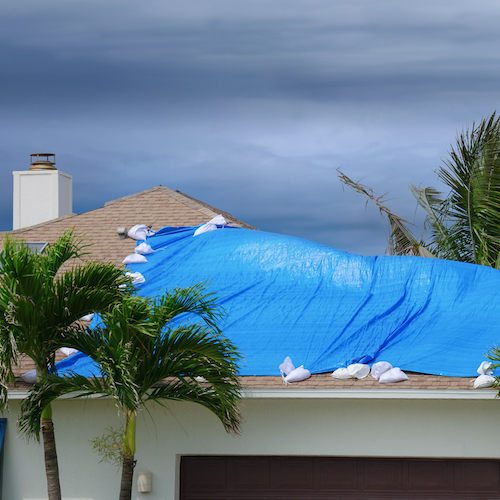
Storm season has officially begun for those living in the Southern US and Mexico — and it’s not slated to be an easy one. For the seventh consecutive year, the National Oceanic and Atmospheric Administration (NOAA) is predicting an above-average period for storms, with the agency forecasting from 14 to 21 named storms from June 1–November 30.
The Southern US is still recovering from the storm season in 2021 with 21 named storms — eight of which made landfall in the United States, causing at least $70 billion in damage. Forbes noted that 90% of that damage came from Hurricane Ida alone, showing just how impactful one storm can be on its own.
Following any type of natural disaster or major weather event, repair and reconstruction work is a high priority, as it has been in recent years — but contractors will also run into weather-related delays and material shortages in the aftermath, making extra preparation beforehand a real key.
Early preparation is key as material and labor shortages could hit harder this year than years before
“Early preparation and understanding your risk is key to being hurricane resilient and climate-ready,” noted NOAA Secretary of Commerce Gina M. Raimondo.
Contractors asked to rebuild in storm-hit areas are always tasked with high expectations, but this year’s stresses could be more significant than in recent years, as material shortages and disruptions to the international supply chain continue to build.
“Copper has doubled, steel has gone up, aluminum has increased,” said Conor Barry, vice president of business development at Miami Systems Inc. He noted that contractors all around are seeing material shortages related to overseas importing, which would be likely impacted in the event of severe weather.
Even prior to the start of storm season in the south, people globally have seen just how supply and labor shortages have had a negative impact on companies’ ability to work. After a major storm in Ottawa, Canada caused severe damage in May 2022, contractors across the area saw a demand that they just couldn’t handle: “about 400 phone calls and about 200 online requests,” according to roofing contractor William Hrynewich.
Getting qualified workers to fill this demand is going to be an extra challenge, too. National Association of Home Builders chairman Jerry Konter noted that “construction labor shortages are running near an all-time high of 400,000 workers” even without the added demand of storms.
Local governments are already moving in advance of the hurricane season — for example, Florida’s Escambia County recently made moves to find new storm debris removal contractors after it dealt with over $44 million in debris hauling during 2021.

Have a question?Levelset can help.
Recovering from a major storm can bring lots of construction payment questions for even the most seasoned professionals.
Read previous questions — and get your questions answered by a community of credit managers, lawyers, and construction professionals, all for free.
Federal initiatives encourage new construction standards in anticipation of storm damage rebuilding
The White House has made a move to incentivize new building codes which would make the nation’s newly rebuilt infrastructure “more resilient to severe weather and the impacts of climate change” according to Federal Emergency Management Agency (FEMA) administrator Deanne Criswell.
Though this seems like it might be just a long-term concern for the Biden administration, it has direct short-term implications, especially for any infrastructure rebuilding required after a storm.
Partly, the plan concerns where the federal government is spending its infrastructure funding: White House officials highlighted the start of storm season as a reason to implement more “hazard resistant” building codes and provide incentives for doing so — meaning that contractors who are more prepared to get repairs and other new construction up to the standards of the new building codes can stay ahead of the curve and benefit early on.
A section of the plan includes the use of $225 million from the Bipartisan Infrastructure Law to implement the new standards and fund new projects in order to “ensure federally-supported housing and other building projects follow modern building codes and standards to the greatest extent feasible.”
The White House isn’t alone in these new initiatives, as FEMA has rules of its own regarding the “Build America, Buy America” requirements outlined as part of the Biden administration’s Bipartisan Infrastructure Law.
The act “requires all federal agencies, including FEMA, to ensure…that no federal financial assistance for infrastructure projects is provided ‘unless all of the iron, steel, manufactured products, and construction materials used in the project are produced in the United States.’”
With FEMA funding often playing a huge part in rebuilding efforts for storm-hit areas, contractors will want to make sure they could fulfill the agency’s Buy America requirements — which is not at all an easy task given the country’s supply chain issues.
Related: USDOT Waives ‘Buy America’ Requirements for Construction Materials — For Now
Contract understanding is crucial in light of severe weather
Storms bring huge damage and new construction every year, but a commonly overlooked aspect of their impact is that which happens to current construction projects. Force majeure events like major storms can cause huge headaches for contractors when they’re trying to wrap up current work.
“No matter how much you try to plan ahead, many projects are ultimately at the mercy of an act of God — weather events, natural disasters, and so on,” writes construction attorney Alex Benarroche. Force majeure clauses relieve a party from performing their contractual obligation under certain circumstances, such as severe weather. Generally, these clauses provide for when work isn’t performed under circumstances that neither party can control.
“Imagine work has begun on a project in Florida,” says Benarroche. “Two weeks into the build, a category 5 hurricane makes landfall in your area. Without a force majeure clause in the construction contract, a contractor could potentially be sued for not completing his work on time.”
Though these clauses serve as a form of protection in these situations, understanding how they fit into your contracts is crucial, as disputes could arise if the contracting parties disagree over the interpretation and use of these clauses.
Construction Weather Delay Claims: Who pays for bad weather?
Prequalification is a must with “storm-chasing” contractors lurking
Sadly for legitimate contractors and consumers alike, “storm-chasing” contractors become commonplace in heavily damaged areas during storm season. These parties often take advantage of damaged areas to commit roofing scams, or are working unlicensed for an area without disclosing so. Local organizations are hoping to crack down on unlicensed and improper contracting in the wake of storms this year.
Related: Florida Roofing Scams Have Insurers and Restoration Contractors on Edge
“Unfortunately, natural disasters lead to an increase in individuals posing as legitimately licensed contractors in an effort to prey upon vulnerable citizens,” said Stephanie Lee, Executive Director of the Mississippi State Board of Contractors. “Individuals who hire unlicensed contractors are putting themselves at great financial risk.”
“It is important to stay vigilant in the aftermath of a natural disaster,” added Florida Department of Business and Professional Regulations (DBPR) secretary Melanie S. Griffin, saying that the presence of improperly licensed contractors in the aftermath of a storm serves as “another disaster.”
This isn’t just a problem for consumers — contractors can put themselves at risk without proper prequalification of businesses they work with.
“One bad egg could affect the project schedule, the quality of performance, project safety, and it could even determine whether payment disputes will occur,” said Alex Benarroche.
Getting information about a contractor’s business history, financial stability, and safety record is a crucial part of ensuring that projects move smoothly and safely.
Is your construction business ready for hurricane season?
Read the guide by experienced Louisana construction attorney Matt Viator now.